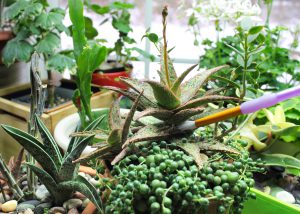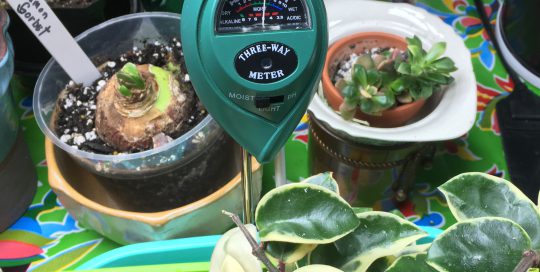This is an article about indoor gardening MacGyvers – you know, making tools out of something originally devised for a different purpose. Nowadays the millennials call them ‘hacks’. So, MacGyvers, hacks, whatever the term, we’ll be looking at the application of items I’ve found especially useful in growing house plants.
Discovering ‘hacks’ is not just a 21st Century phenomenon, of course. Dozens of inventions fashioned centuries earlier are still in use by modern gardeners. Hand pruners, and many of their offshoots, were invented in 1818 by the Marquis de Moleville for use by French vineyard workers. By the late 19thcentury they had replaced the commonly used billhooks, which now reside in tool heaven along with VHS tapes and dial-up telephones.
When it comes to growing plants, as with any endeavor, items that have lived their entire lives in the kitchen can be called into play by a gardener. One of the most famous examples of repurposing is when the Microplane© went from wood shop to kitchen as a handy grater for everything from nutmeg to lemons.
I haven’t put my Microplane to work as a garden tool, but many of my makeshift implements came from the garage toolbox or my office, while several are refugees from a failed craft project. Since most of my houseplants are in my sunroom, which is right off the kitchen, it makes sense many of my houseplant care helpers once had jobs in meal prep. Here are ten that might already be in your garden tool roster.
-
Artists’ brushes
Brushes are especially handy for succulents, which resent being sprayed with water on a regular basis. I use little craft brushes I’ve purchased for a variety of forgotten projects, or extra makeup brushes. They work wonders after the messy act of transplanting, when most succulents shouldn’t be cleaned off in the sink, but can be dusted off with a nice little concealer brush.

Artist Brush (photo by Jean Starr)
-
Pencils (and a sharpener)
They’re perfect for tests, and even more so for indoor gardening. When you’re finished with the test, take that No. 2 pencil (or any other number) home and use it to check moisture levels in your houseplants. Insert a freshly sharpened pencil as close to the bottom of the pot as possible. If the new wood comes up dry, it’s time to water. If it comes up with soil clinging to it, wait awhile. Pencils are also ideal for making holes in the soil for new cuttings.
-
Yogurt or other dairy product containers
Pretty much any container in the dairy aisle can be used as a drip-catcher. I buy my yogurt based partly by its container, which is perfect for 3” pots. These plastic, logo-strewn vessels aren’t pretty, but can catch drips just as well as those thin plastic plant saucers.
-
Needle-nosed pliers
I love the needle-nose pliers I found in the garage. I use them to pick up debris I’ve dropped between those wicked succulent thorns, or even to grab and remove dead leaves that are hard to reach. The long-nosed types are perfect for placing plants and other items into a terrarium (the best kind of indoor gardening).
-
Turkey baster
I lost the first one I cadged from the kitchen, so the turkey baster I’m using now for my houseplants was purchased just for them. I use it to catch overflows, hopefully before flow out of their intended reservoir. It’s happened to me more than once. Even with a drip-catching saucer, I’ve poured in so much water that it starts to spill over. Keep the baster in an empty bottle heavy enough to stand up while not in use. This method works best for larger pots and saucers that are at least an inch deep.
-
Chopsticks, coffee stirrers
These temporary sticks are invaluable for houseplants. When hanging plants are just getting started, they can be clipped to an upright stake so they don’t take up as much space, and so it’s easier to pinch back growth, and keep stems from getting tangled. The sticks also work well for keeping new cuttings from getting knocked around while they’re rooting. I use orchid clips to attach stems to their supports.

Take-out Chopstick (photo by Jean Starr)
-
Measuring cups
Even my largest trowel isn’t big enough to scoop soil into my containers. Which is why I’ve commandeered a 1-cup measuring cup for the purpose. Pick one that is sturdy and has a nice-sized handle. In the past, I’d used pots to scoop soil into other pots. However, most of them are made of such thin plastic, they just don’t hold up for that purpose. To be really thrifty, browse your local thrift-store for some real garden worthy scoop-finds for indoor gardening.
-
Marbles or small rocks
Using a cachepot, or a decorative planter, is the easiest way to spruce up a gorgeous plant grown in a ho-hum pot. I use a variety of ceramic cachepots, woven baskets and sometimes metal containers to disguise a typical plastic pot that the plant is growing in. You don’t even have to take the plant out of the pot—just set it into the cachepot.

Cache Pots (photo by Jean Starr)
To prevent your plant from sinking too deeply into the cachepot, I use a layer of small rocks or other inert filler to give it a boost. This layer of filler also serves to prevent the plant from sitting in water, as the rocks will lift the roots above it. Pretty pebbles can be purchased at craft shops, but I seek them out on a nearby beach.
Other items that I have recycled for use at the bottom of a cachepot and indoor gardening include vase fillers — either glass or acrylic — extruded clay pebbles used in hydroponics. (wash them well if newly purchased), and Scrabble tiles.

Drainage Bits (photo by Jean Starr)
-
Strainer
From time to time, the rocks at the bottom of a cachepot get dirty, especially if they’ve been sitting in water that’s gone through the soil in a pot. I remove the plant, pour the rocks and all through a strainer and into a plastic tub. Empty the dirty water and clean the tub. Replace the water with clean, sudsy water to which a small amount of bleach is added. Pour the drained yet still-dirty rocks into the clean sudsy water and swirl it around so they all get clean. Wash the strainer and strain the washed rocks. Rinse the rocks well while still in the strainer. Pour the contents into a strainer, letting the dirty water drain into a sink or extra vessel of some kind. I use an old plastic canister. It sounds complicated but isn’t, especially if you have a good strainer.
-
Saucers
Cups and the accompanying saucers have been eclipsed by the mug. But, saucers can be recycled as drip-catchers or furniture-protectors under pots with drainage. And who doesn’t have a set of grandma’s dishes? Most saucers have a small indentation where the bottom of the cup fits. It will beautifully catch a bit of excess.
I’m sure there are dozens more instances of inventive improvisations for indoor gardening. It helps to have a well-stocked kitchen junk drawer, a memory for where you put things you might have a use for, and time to go searching for an implement that will do the trick when you need just the right gizmo for the job. Gardening is the original make-shift hobby. After all, most plants won’t live in the same pot their whole life. They always require repotting, clipping, dividing, staking, and cleaning (hopefully) for a very long time.










